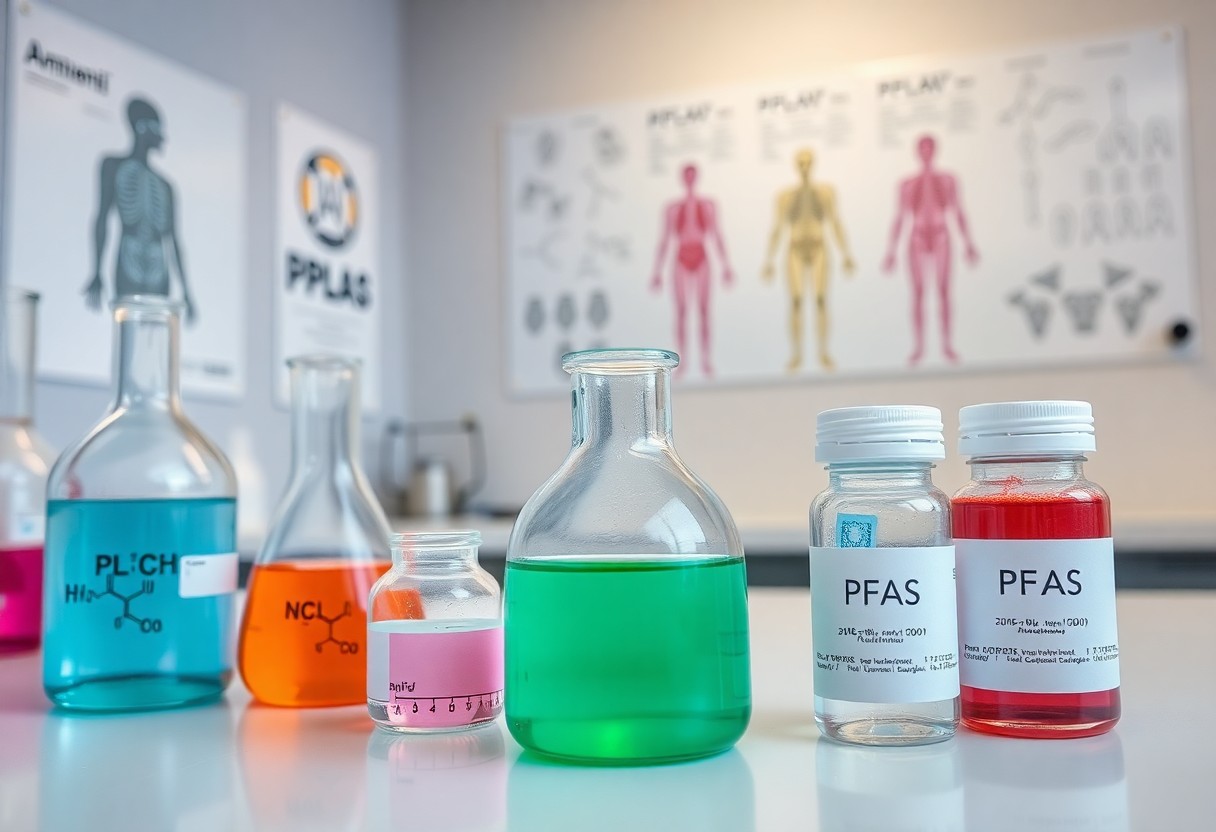There’s a growing concern about the safety of your family’s drinking water, particularly regarding the presence of PFAS (per- and polyfluoroalkyl substances). These chemical compounds have been linked to a variety of health risks, and they can easily infiltrate water supplies through multiple pathways. Understanding how PFAS spreads and the potential sources of contamination can empower you to take proactive steps to ensure the safety of your household water. Stay informed and safeguard your family’s health by learning more about this pressing issue.

Understanding PFAS
A comprehensive understanding of PFAS is vital for you to recognize its potential impact on your health and environment. Per- and polyfluoroalkyl substances (PFAS) are a group of synthetic chemicals that have been widely used in various industries since the 1940s. Known for their resistance to heat, water, and oil, these substances can accumulate in the environment and your body, leading to long-term health risks.
What are PFAS?
After decades of use, PFAS have gained attention due to their persistence and potential to cause health issues. These chemicals, often referred to as “forever chemicals,” do not break down easily in the environment or human body, leading to concerns about their long-term effects, including cancer and hormonal disruptions.
Sources of Contamination
After learning about PFAS, it’s vital to identify the specific sources that may be contaminating your drinking water. Common sources include industrial discharges, firefighting foams, and products like non-stick cookware and waterproof clothing that contain PFAS chemicals.
What you may not realize is that PFAS can infiltrate your drinking water from multiple sources. Manufacturing facilities that produce or utilize PFAS often discharge these chemicals into nearby water bodies. Additionally, the extensive use of firefighting foam at training sites and airports contributes to contamination. Even landfills can leach PFAS into groundwater as waste breaks down. By understanding these sources, you can take proactive steps to protect your family’s health.
Pathways of PFAS Spread
Even the most everyday items can contribute to the spread of PFAS in your environment. These substances can permeate various pathways, leading to contamination of your drinking water. Sources such as industrial discharge, atmospheric deposition, and consumer products like non-stick cookware and stain-resistant fabrics can all release PFAS into the soil and water systems, posing significant risks to your family’s health.
Water Supply Systems
To understand the impact on your drinking water, it’s crucial to note that PFAS can infiltrate municipal and private water supply systems. These chemicals can enter systems through contaminated surface water or groundwater, resulting in widespread exposure. As a result, you might inadvertently consume PFAS-laden water, which is harmful to your health.
Soil and Groundwater Contamination
About 60% of PFAS found in the environment comes from the leaching of chemicals into the soil and groundwater. When products containing PFAS decompose, they can release these hazardous substances into the ground, which then seeps into nearby waterways and aquifers. This contamination can persist for years, putting your drinking water supply at risk.
Pathways of PFAS contamination are complex and alarming. When PFAS leach into the soil, they can migrate deep into the ground, affecting groundwater supplies. Your family may unknowingly be exposed to harmful levels of these chemicals through well water or municipal sources that draw from contaminated aquifers. The persistence of PFAS in the environment means that even minimal exposure can lead to significant health issues, making it vital for you to stay informed and proactive about testing your water supply.
Health Implications of PFAS Exposure
Some studies suggest that exposure to PFAS can lead to serious health implications. These substances, often referred to as “forever chemicals,” are linked to various health issues, including hormone disruption, immune system effects, and even certain types of cancer. Understanding the risks associated with PFAS exposure is vital for protecting you and your family’s well-being.
Short-Term Effects
Along with the increasing concern about PFAS, short-term exposure can lead to immediate health effects. These may include skin irritation, stomach issues, and changes in liver function. Although these effects may seem minor, they serve as warning signs of potential underlying health conditions related to chemical exposure.
Long-Term Health Risks
Behind the short-term effects, the long-term health risks of PFAS exposure are far more concerning. Chronic exposure is associated with serious conditions such as kidney cancer, testicular cancer, and liver disease. Studies show that these chemicals can accumulate in your body over time, leading to detrimental effects on your overall health and increasing your risk of developing chronic diseases.
With ongoing research highlighting the dangers of PFAS, it’s important to understand how these chemicals accumulate in your system. Evidence indicates that long-term exposure can result in impaired immune function, elevated cholesterol levels, and developmental issues in children. Furthermore, PFAS exposure has been linked to thyroid disease and pregnancy complications, leaving lasting impacts on your health. Being proactive in reducing your exposure can help safeguard you and your loved ones from these potential risks.
Testing for PFAS in Drinking Water
To ensure your drinking water is safe, testing for PFAS is necessary. There are various options available that cater to different needs. Whether you opt for home testing kits or rely on municipal water authorities, understanding the testing process can help you take actionable steps to safeguard your family’s health. Being informed about the presence of PFAS is the first step towards effective management and remediation.
Home Testing Kits
One effective way to assess your water quality is by using home testing kits designed for PFAS detection. These kits allow you to conveniently collect a sample from your tap water and send it to a lab for analysis. They can give you immediate insights into the PFAS levels in your drinking water, empowering you to make informed decisions about filtration or alternative water sources.
Municipal Water Testing
Water supplied by your local municipality is tested for contaminants, including PFAS. Municipalities are required to regularly monitor your drinking water quality to comply with safety regulations. However, this testing may not always cover every type of PFAS or the specific needs of your community.
Further, municipal water testing results can vary significantly depending on your location, making it important for you to review the annual water quality report released by your local water provider. This report typically includes data on contamination levels, including PFAS, but may not fully represent seasonal fluctuations or specific point-source contamination. If levels of PFAS detected are above safety guidelines, it can pose health risks, underscoring the importance of demanding transparency and proactive measures from your local authorities to ensure your family’s drinking water remains safe.
Mitigation Strategies
Keep your family’s drinking water safe by adopting effective mitigation strategies. This includes using water filtration systems, staying informed about local water quality reports, and advocating for stronger regulations that limit PFAS contamination. By taking proactive measures, you can reduce your exposure and protect your loved ones from the harmful effects of these persistent chemicals.
Filtration Options
For effective reduction of PFAS in your drinking water, consider advanced filtration systems such as activated carbon filters, reverse osmosis units, or ion exchange systems. These technologies can significantly lower PFAS levels, providing you with cleaner, safer water for everyday use.
Policy and Regulation Efforts
One way to combat PFAS contamination is through policy and regulation efforts. Advocacy for stricter regulations and standards depends on engagement from you and your community. By supporting local and national initiatives, you contribute to the push for enhanced water safety measures.
Options for policy and regulation efforts include lobbying for new legislation that sets lower allowable limits on PFAS in drinking water and promoting transparency in water quality reporting. Your voice can help raise awareness and pressure lawmakers to implement stronger protections against PFAS contamination. These efforts not only aim to safeguard your family’s health but also seek to hold industries accountable for their role in pollution. Empowering communities and advocating for change can lead to significant advancements in public health and safety.
Community Action
Unlike many environmental issues that are often overlooked, the contamination of drinking water with PFAS calls for immediate community response. You can become an active participant in ensuring your family’s health by joining efforts with local organizations, attending town hall meetings, and advocating for measures that promote clean water initiatives. By collaborating with your neighbors and community leaders, you can amplify your voice and drive meaningful change.
Advocacy for Clean Water
Beside individual efforts, advocating for clean water at a community level is fundamental for raising awareness about PFAS contamination. You can support initiatives that target pollution reduction and push for stricter regulations. Through community campaigns, you’ll align with fellow residents who share your concerns, fostering a stronger collective movement aimed at safeguarding your water supply.
Engaging Local Governments
Advocacy is imperative when it comes to engaging local governments about PFAS contamination. Your role involves urging officials to take decisive action, including implementing measures for testing and cleaning contaminated water sources. You can write letters, attend public meetings, and join local advocacy groups to put pressure on decision-makers for policy changes that protect your community.
Community engagement plays a pivotal role in addressing PFAS contamination. You can tap into local resources by attending town hall meetings and forming coalitions with other concerned citizens. By demanding transparency from your local government, you can support initiatives such as water testing and improved regulations. These efforts can lead to better monitoring of water quality and more stringent measures to ensure the safety of your drinking water. Together, you and your community can create a more supportive environment in which your health is prioritized.
To wrap up
Hence, understanding the sources and pathways of PFAS contamination is vital for safeguarding your family’s drinking water. By being aware of potential risks and taking measures to test and filter your water, you can protect your health and that of your loved ones. Stay informed about local water quality reports and advocate for proper regulations to ensure safer water supplies in your community. Awareness and action can make a significant difference in minimizing your exposure to these harmful substances.





















